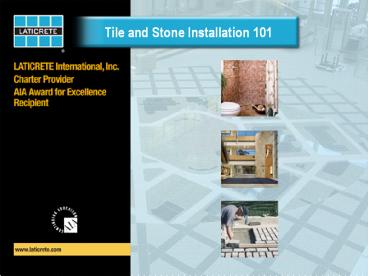Tile and Stone Installation 101 PowerPoint PPT Presentation
1 / 27
Title: Tile and Stone Installation 101
1
Tile and Stone Installation 101
2
Tile and Stone Installation 101
3
Why use Ceramic tile and stone? What are the
benefits? How can the right tile or stone be
specified? How can the right installation
materials be specified?
4
Beauty, Durability, Value
Ceramic tile and stone offer Unlimited design
options Color Texture Pattern Finish
Low life cycle cost Easy maintenance
5
Tile of any color is Green!
Tile is all natural Tile installation
materials can be Non-allergenic Low or no VOC
LEED certification
6
Installation is EVERYTHING
Two things determine success Proper selection
of methods and materials Successful
implementation by installers
7
Selecting the Right Methods
Reference Standards Tile Council of North
America (TCNA) Handbook for Tile
Installation ANSI A118 Materials A108
Installation Methods Marble Institute of
America Dimensional Stone Design Manual
Manufacturers Recommendations
8
Four Most Important Considerations
For what use is the installation intended?
Any limitations on installation method? What
type of tile or stone is desired? What is the
substrate?
9
Intended Purpose?
Interior, exterior Wall, floor, countertop,
soffit Foot or vehicular traffic Wet
area Intermittent exposure Continuous
submersion Thermal or chemical exposure
10
Limitations on Installation Methods?
Design thickness Dead load/live load Slope
in wet areas Substrate
11
What Type of Tile or Stone?
Quarry, ceramic, porcelain, or glass Glazed
or unglazed Gauged or ungauged Dimensions
12
What is the Framing Substrate Type?
Wood Framing Floor Wall Metal
Framing Wall Solid Backing Concrete
floor Masonry wall
13
Incompatible for Direct Bond
The notorious and egregious Concrete with
curing compound or sealer Oriented
strand board Interior grade plywood
Marine grade plywood Fire rated plywood
Luan Masonite
14
Deflection Requirements
What is deflection? Deflection criteria Ceramic
tile 1/360 Stone 1/480
15
Planning for Movement
Expansion joints are REQUIRED! TCNA EJ-171
16
Start With a Sound Base
Surface preparation is key
17
Preventing Water Damage
When use of a membrane makes good sense
18
Preventing Cracked Tile and Grout
When the use of an anti-fracture membrane makes
good sense
19
Select the Correct Adhesive
Thin, medium or thick? Cement based or
epoxy? Rapid set, or conventional?
20
Grout and Sealant Critical Final Steps
Only visible components of installation
Cost is a small fraction of total Responsible
for high percentage of complaints and claims
21
Maintenance Requirements
Tile is not maintenance free Proper
cleaners Staining Sealant
22
Summary
Why should tile be specified? Consider the four
points prior to the installation. Use the right
installation products.
23
End of AIA/CES Presentation
24
Why LATICRETE?
Focus Innovation Proven Performance
Comprehensive Warranties Superior Technical
Support 800.243.4788, ext. 235 Live, Local
Technical Representatives Senior Architectural
Specialists ISO 9000
25
(No Transcript)
26
Fast and Reliable Generates
Specification Execution Statement
Detail Options for Submittal Packages
Editable Details
27
Thank You
DS-7058-0905

